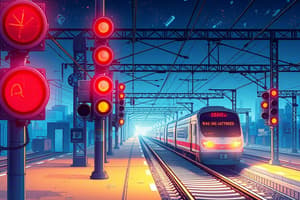Podcast
Questions and Answers
What is the primary purpose of signaling systems in train operations?
What is the primary purpose of signaling systems in train operations?
- To enhance the aesthetic design of train stations.
- To ensure safe train operations and prevent collisions. (correct)
- To maintain train schedules only.
- To automate ticketing processes.
Which type of signal uses physical levers and arms to indicate train routes?
Which type of signal uses physical levers and arms to indicate train routes?
- Digital Signaling
- Mechanical Signals (correct)
- Position Light Signals
- Color Light Signals
How do interlocking systems contribute to train safety?
How do interlocking systems contribute to train safety?
- By monitoring environmental conditions.
- By ensuring trains operate on automatic pilots.
- By preventing conflicting movements and ensuring correct signal settings. (correct)
- By tracking train speed over long distances.
What does the term 'digital signaling' refer to?
What does the term 'digital signaling' refer to?
Which modern signaling technology is designed to prevent accidents via automated responses?
Which modern signaling technology is designed to prevent accidents via automated responses?
What role does track circuiting play in train safety?
What role does track circuiting play in train safety?
What does a 'stop signal' indicate to a train?
What does a 'stop signal' indicate to a train?
Which of the following is a method of regulating train speed according to signals?
Which of the following is a method of regulating train speed according to signals?
Flashcards are hidden until you start studying
Study Notes
Signalling Systems
- Purpose: Ensure safe train operations, managing train movements and preventing collisions.
- Types:
- Mechanical Signals: Physical levers and arms to indicate train routes.
- Color Light Signals: Use colored lights to convey information (e.g., red for stop).
- Position Light Signals: Indicate the position of the train using lights arranged in a vertical or horizontal format.
Safety Measures
- Interlocking Systems: Prevent conflicting movements by ensuring signals and points are set correctly.
- Automatic Train Protection (ATP): Monitors train speed and enforces compliance with signals.
- Track Circuiting: Detects the presence of trains in specific sections of track to prevent signal showing clear when occupied.
- Signal Overlap: Distance beyond the signal where safety measures ensure a train can stop if the signal is red.
Modern Signalling Technologies
- European Train Control System (ETCS): Standardizes signalling across Europe for interoperability.
- Centralized Traffic Control (CTC): Allows central management of train movements over large areas.
- Positive Train Control (PTC): Advanced safety system in the U.S. that prevents accidents through automated responses.
- Digital Signalling: Utilizes digital communications for real-time data exchange between trains and control centers.
Aspects Of Train Control
- Train Dispatching: Coordinating train schedules to maintain efficiency and safety.
- Block Systems: Divides the track into segments to manage train occupancy.
- Speed Control: Regulating train speed according to signal indications and track conditions.
- Communication-Based Train Control (CBTC): A system that uses wireless communication for real-time position tracking and control.
Types Of Signals
- Stop Signals: Indicate the train must halt (e.g., red light).
- Proceed Signals: Indicate trains may proceed (e.g., green light).
- Caution Signals: Warn of upcoming restrictions (e.g., yellow light).
- Shunting Signals: Used for switching trains in depots or yards.
- Distant Signals: Provide advance warning of the status of the next signal ahead.
Signalling Systems
- Purpose is to ensure safe train operations, effectively managing movements and preventing collisions.
- Mechanical signals utilize physical levers and arms to indicate train routes and movements.
- Color light signals employ colored lights, with red indicating a stop, to convey status to trains.
- Position light signals display the train's status through lights that are organized either vertically or horizontally.
Safety Measures
- Interlocking systems prevent conflicting train movements by ensuring signals and points are configured correctly.
- Automatic Train Protection (ATP) continuously monitors train speed and ensures compliance with signal indications.
- Track circuiting identifies train presence in specific track sections, preventing miscommunication when tracks are occupied.
- Signal overlap denotes a safety buffer beyond a signal, ensuring a train can stop if the signal is showing red.
Modern Signalling Technologies
- European Train Control System (ETCS) standardizes signalling across Europe to facilitate interoperability among different train systems.
- Centralized Traffic Control (CTC) provides a method for central management of train movements over extensive rail networks.
- Positive Train Control (PTC) is an advanced safety system implemented in the U.S. designed to prevent accidents through automated responses.
- Digital signalling harnesses digital communications to allow real-time data exchange between trains and control centers.
Aspects Of Train Control
- Train dispatching is essential for coordinating schedules, aiming to maintain both efficiency and safety.
- Block systems segment tracks to effectively manage train occupancy and ensure safe distances between trains.
- Speed control involves regulating a train's speed based on signal indications and prevailing track conditions.
- Communication-Based Train Control (CBTC) uses wireless technology for accurate real-time position tracking and operational control.
Types Of Signals
- Stop signals, usually represented by a red light, indicate that the train must halt.
- Proceed signals, indicated by a green light, allow trains to continue movement.
- Caution signals, represented by a yellow light, warn trains of upcoming restrictions or hazards.
- Shunting signals are specifically used for maneuvering trains within depots or yards.
- Distant signals provide advance warnings regarding the status of the next signal, enhancing situational awareness for operators.
Studying That Suits You
Use AI to generate personalized quizzes and flashcards to suit your learning preferences.



